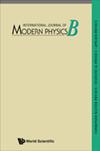Optimization of mixed cation organic–inorganic lead halide perovskite solar cell performance
IF 2.8
4区 物理与天体物理
Q2 PHYSICS, APPLIED
引用次数: 0
Abstract
In this paper, the experimentally studied perovskite solar cell structure, ITO/SnO 2 /(FAPbI 3 )[Formula: see text] (MAPbBr[Formula: see text]Cl y ) x /Spiro-OMeTAD/Au, is considered as our primary cell structure. The Solar Cell Capacitance Simulator is used to investigate the cell performance. The cell performance is obtained after optimizing the influence of layer thickness (open circuit [Formula: see text][Formula: see text]V, short circuit [Formula: see text][Formula: see text]mA/cm 2 , fill [Formula: see text]%, power conversion [Formula: see text]%). In addition, various inorganic hole transporting layers are incorporated in place of Spiro-OMeTAD to improve cell stability and performance. Finally, with an open circuit [Formula: see text][Formula: see text]V, a short circuit [Formula: see text][Formula: see text]mA/cm 2 , a fill [Formula: see text]%, and a power conversion efficiency = 19.55%, the optimized cell structure i.e., ITO/SnO 2 /(FAPbI 3 )[Formula: see text](MAPbBr[Formula: see text]Cl y ) x /CulnSe 2 /Au, performs better. The cell performance is examined in relation to defect density in the absorber layer and at the layer interface. The primary cell results are also validated with the existing experimental results in the literature. This research will pave the way for the development of highly efficient mix-cation perovskite solar cells.混合阳离子有机-无机卤化铅钙钛矿太阳能电池性能优化
本文实验研究的钙钛矿型太阳能电池结构,ITO/SnO 2 /(FAPbI 3)[公式:见文](MAPbBr[公式:见文]Cl y) x /Spiro-OMeTAD/Au,被认为是我们的主电池结构。利用太阳能电池电容模拟器对电池性能进行了研究。优化层厚影响后获得电池性能(开路[公式:见文][公式:见文]V,短路[公式:见文][公式:见文]mA/ cm2,填充[公式:见文]%,功率转换[公式:见文]%)。此外,还加入了各种无机空穴传输层来代替Spiro-OMeTAD,以提高电池的稳定性和性能。最后,在开路[公式:见文][公式:见文]V,短路[公式:见文][公式:见文]mA/ cm2,填充[公式:见文]%,功率转换效率= 19.55%的情况下,优化后的电池结构为ITO/SnO 2 /(FAPbI 3)[公式:见文](MAPbBr[公式:见文]Cl y) x /CulnSe 2 /Au。电池的性能与吸收层和层界面处的缺陷密度有关。原代细胞的结果也与文献中已有的实验结果进行了验证。这项研究将为高效混合阳离子钙钛矿太阳能电池的发展铺平道路。
本文章由计算机程序翻译,如有差异,请以英文原文为准。
求助全文
约1分钟内获得全文
求助全文
来源期刊

International Journal of Modern Physics B
物理-物理:凝聚态物理
CiteScore
3.70
自引率
11.80%
发文量
417
审稿时长
3.1 months
期刊介绍:
Launched in 1987, the International Journal of Modern Physics B covers the most important aspects and the latest developments in Condensed Matter Physics, Statistical Physics, as well as Atomic, Molecular and Optical Physics. A strong emphasis is placed on topics of current interest, such as cold atoms and molecules, new topological materials and phases, and novel low dimensional materials. One unique feature of this journal is its review section which contains articles with permanent research value besides the state-of-the-art research work in the relevant subject areas.
 求助内容:
求助内容: 应助结果提醒方式:
应助结果提醒方式:


